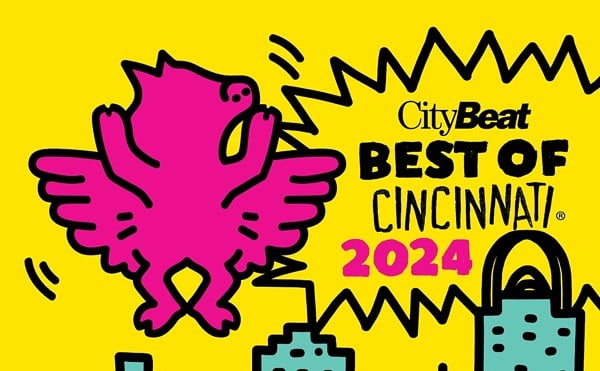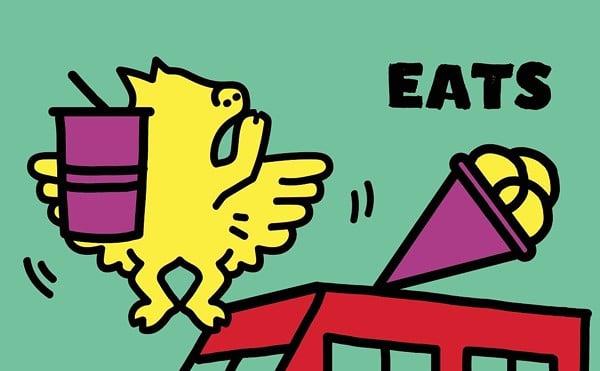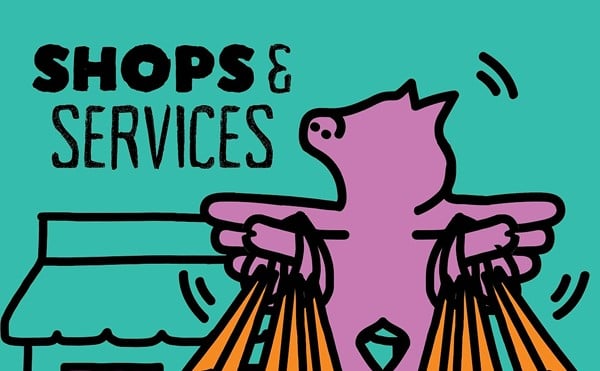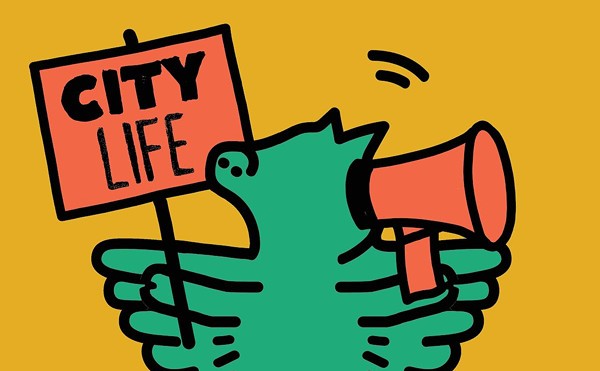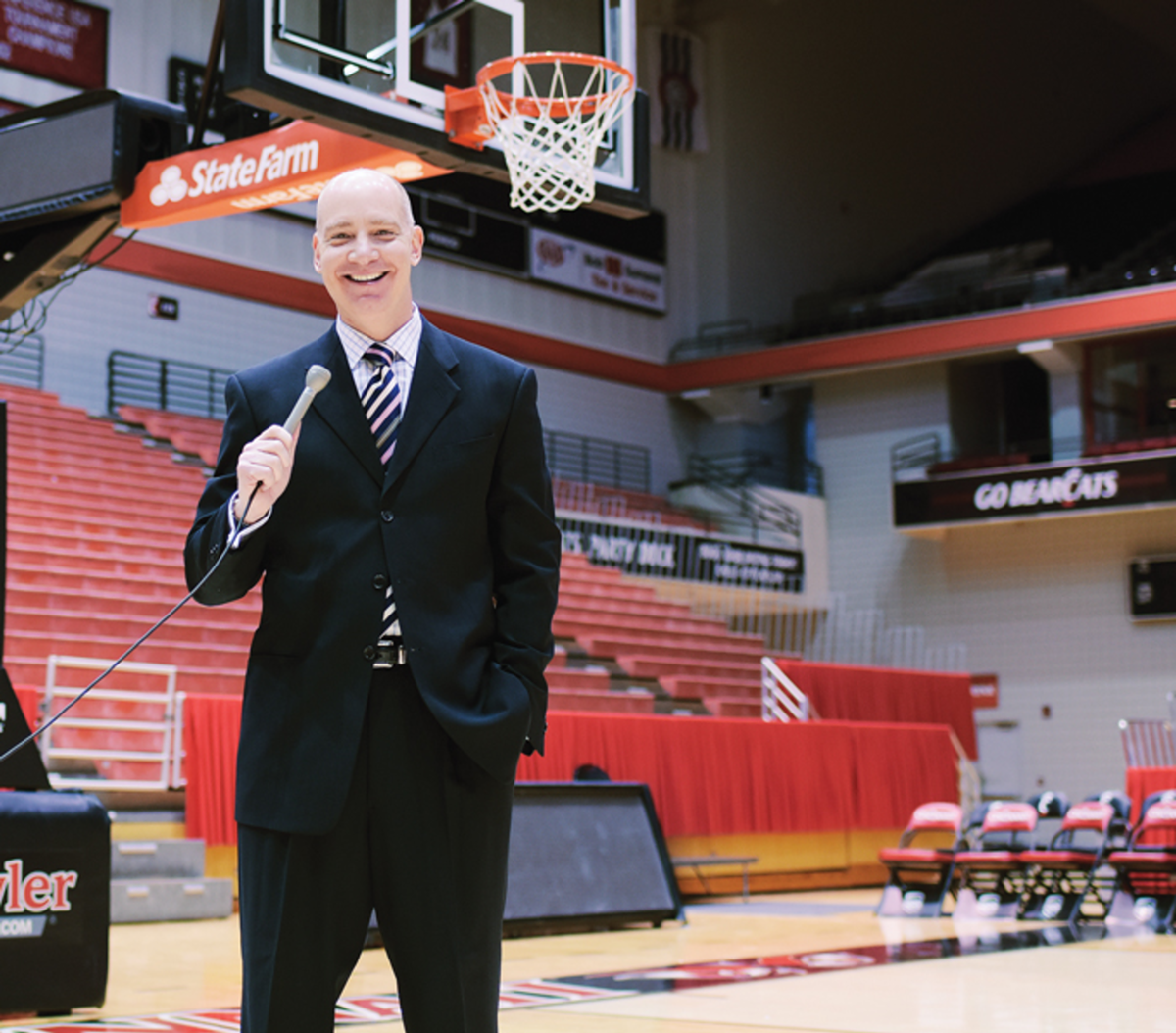
Dan Hoard
Cincinnati is a dedicated but long-suffering sports town. Few know this better than Dan Hoard, whose presence in Cincinnati coincides with our city’s hard-luck results over the last 20 years.
The Reds, Major League Baseball’s oldest franchise, haven’t won a playoff series since 1995. The Bengals, founded by one of the National Football League’s enduring icons, haven’t won a playoff game since 1991. Even our consistently successful college basketball teams, the Xavier Musketeers and Cincinnati Bearcats, have failed to reach the Final Four over the last two decades.
Yet Hoard, the play-by-play voice of the Bengals and UC’s football and basketball teams, is the first to stand up for his adopted hometown. “I think it’s a great sports town,” Hoard says. “People get ticked off easily, because they’ve been kicked down so many times since 1995, but they’re still there, they still show up and they still listen. It’s a great place to work, and having grown up in a city that had no professional teams of its own, I love being in the middle of it all.”
In a city also known for spawning superior broadcasters — former Bengals wide receiver and local resident Chris Collinsworth is widely considered the NFL’s best television analyst, and Reds radio announcer Marty Brennaman is already a Hall of Famer, to name just two — Hoard more than holds his own as one of the best-prepared and perpetually enthusiastic voices in the business. And now the love is mutual: Hoard was recently named Ohio Sportscaster of the Year by a group of his peers.
“I’m flattered,” Hoard says. “It’s nice in Ohio because Marty (Brennaman) is one of the best ever; Tom Hamilton, the (Cleveland) Indians announcer, is fantastic; Jim Donovan, the Cleveland Browns radio announcer, is one of my favorites; and Paul Keels, at Ohio State, is one of the best college broadcasters in the country. It really is a who’s who kind of state, so to win is kind of cool.”
Hoard grew up in Jamestown, N.Y., a small town about 70 miles south of Buffalo that is best known, according to its native son, as the “birthplace of Lucille Ball and the 10,000 Maniacs.”
He was a sports freak from the get-go. “I always knew I wanted to be a sports announcer — I mean always,” he says. “Came out of the womb, slap me on the ass and that’s what I wanted to do.”
Like many a sports freak, once he realized he would never be a professional athlete himself, Hoard spent most of his free time trying to figure out how to stay immersed in his obsession.
“In high school and even earlier I was plotting how to do it,” Hoard says, laughing as he looks back to his youth. “I was turning the sound down on the TV and practicing into my cassette tape recorder when those still existed. I signed up for the high school debate team even though it was probably the least popular club in the school, just because I knew it would help me gain experience as a public speaker.”
Van Miller, longtime voice of the Buffalo Bills, was Hoard’s sportscasting hero, a role model for his own future endeavors. Yet when it came time for Hoard to further his broadcasting education, a different sportscaster had a big impact.
“I picked up a paperback written by Marv Albert called Yesss, and he mentioned in there that he went to Syracuse,” Hoard says. “He was the only sportscaster I ever heard say what college he went to, so therefore I thought, ‘That must be the place to go.’ And it turned out to definitely be the place to go, because when I was there my fellow students were so talented and so freakishly competitive and into it, that it was the greatest possible training ground for getting into the business.”
Hoard graduated from Syracuse in 1985 and immediately landed a gig as the play-by-play guy for the Boston Red Sox AAA franchise in Pawtucket, R.I. Baseball is still his first love and an indispensible building block in his road to broadcasting success. “The sheer amount of repetitions — 144 games in 152 days — and just doing it three hours a night was like a writer committing himself to cranking it out every day and making sure you get something on paper.”
It wasn’t long before Hoard added television duties to his resume when college classmate and longtime ESPN announcer Mike Tirico recommended him for the vacated sports director job at WTVH-TV in Syracuse. He eventually moved on to Cincinnati in 1995 as the sports director at FOX-19 when his then-girlfriend, now-wife Peg Rusconi got a news reporter job at Channel 12. A year later he began his long-running stint calling Bearcats basketball. His first game was pretty memorable — the 1996 Crosstown Shootout, in which XU’s Lenny Brown hit a last-second shot to beat then-No. 1 UC.
When Rusconi landed her dream job as a reporter back in Boston, the couple tried the separate city thing for a while, but the opportunity to do Pawtucket Red Sox radio eventually moved Hoard back east, too. He continued doing the Bearcats football and basketball games while living in Boston, flying back and forth during the Pawtucket offseason, until it was his turn to land a dream gig — and move his family to Cincinnati full-time. In 2011, Hoard became the play-by-play man with the Bengals, joining longtime analyst Dave Lapham in the booth.
“When I got the job, Lap called me up to congratulate me, and in the course of the conversation he goes, ‘Well, I’ve been doing the games for 25 years, and we’ve had five winning seasons.’"
“My man saw a lot of bad football without losing his enthusiasm,” Hoard says when asked about Lapham’s tendency to go crazy in the booth, “so he’s earned the right to scream and get excited when good things happen after making it through the ’90s with a smile on his face.”
Now fully entrenched as a Cincinnati sports landscape staple — very few sportscasters in any city have enjoyed such a ubiquitous presence — Hoard is ready for a long, Marty Brennaman-like run behind the mic.
“Had I gone to Syracuse and then gone back to my small hometown and done a high school game of the week, I think I would have been happy,” Hoard says. “But I’m glad it didn’t turn out that way. I just really wanted to do sports on TV or radio, so in some ways reality has exceeded the dream.” ©
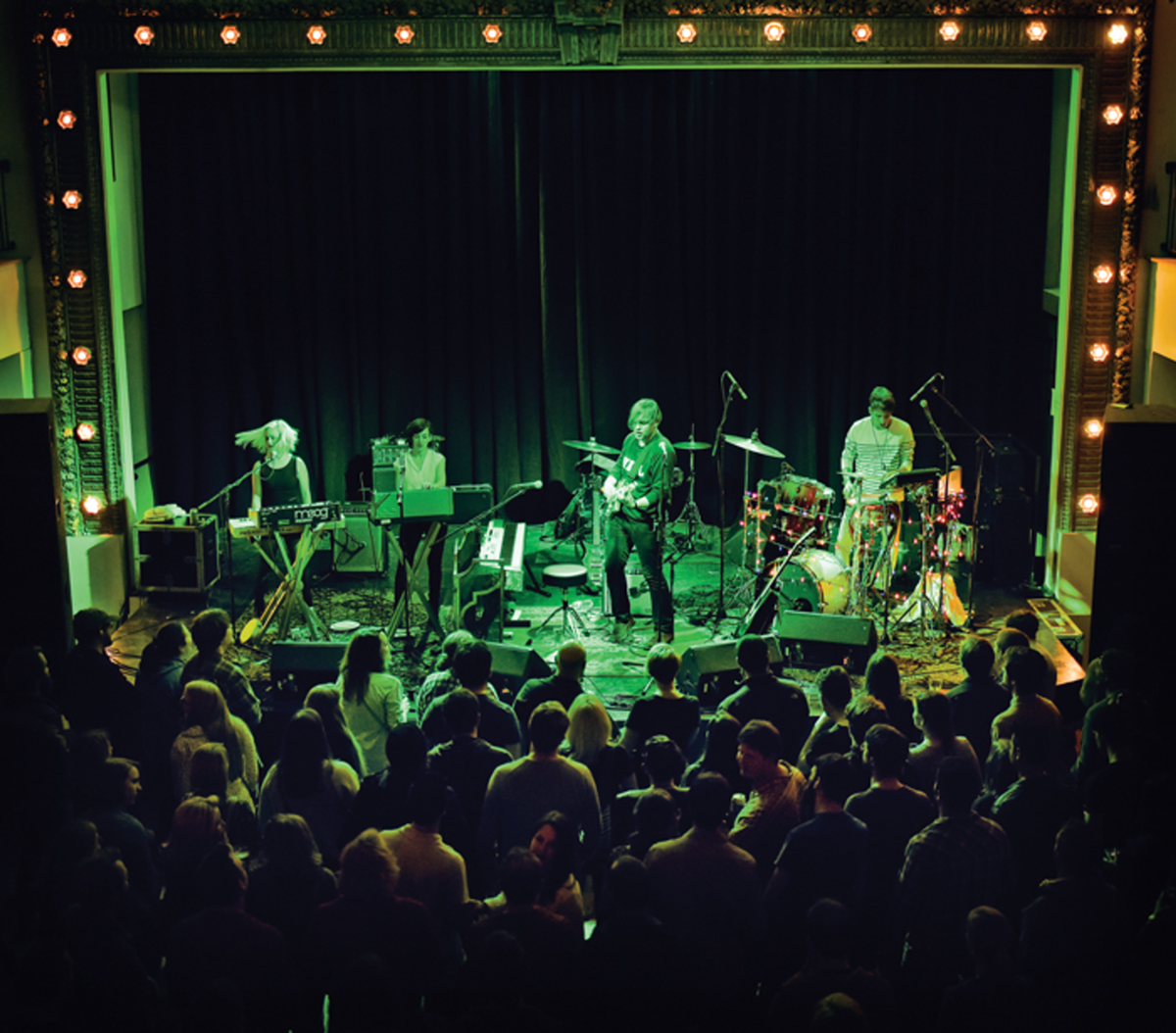
Woodward Theater
Like Liam Neeson’s Bryan Mills from the Taken franchise, Dan McCabe has a specific skill set. He will find you and he will kill you … with music.
McCabe’s unique vision for Cincinnati is evidenced in the booking prowess that gave meaning to the tagline “Rock & Roll Laundry” at former Corryville club Sudsy Malone’s, not to mention his incredible run of shows at the original Southgate House in Newport, his brilliant leadership in the evolution of the MidPoint Music Festival and his determination in turning a run-of-the-mill Main Street bar in Over-the-Rhine into MOTR Pub, one of the Midwest’s premier music venues.
A creative restlessness lies at the heart of McCabe’s activities, rooted in his love of music, his deep affection for Cincinnati and his passionate desire to make the city a better place for everyone. His latest project, the renovation and resurrection of the Woodward Theater in Over-the-Rhine, is another impressive example of his transformative perspective.
Seven years ago, McCabe and business partner Chris Schadler (former Southgate House booker and guitarist/vocalist for Fists of Love) were property shopping in OTR for a new neighborhood music hotspot. McCabe and Schadler were intent on finding a theater-scaled situation, but after several opportunities fell through they switched gears to a bar/restaurant model and bought the former Coopers on Main, turning it into MOTR in 2010. As renovations began, McCabe still obsessed about his theater. “We started chipping away, and we’d look out the window when we had time,” McCabe says with a laugh over beers on the Woodward balcony. “And it was like, ‘Look at that place over there.’ ”
McCabe’s attention had been drawn to the old Woodward Theater, located almost directly across the street from MOTR. Once the site of the old William Woodward mansion, the original wood structure was demolished, replaced by the 1913 Art Deco building that became home to a neighborhood movie theater.
After the Woodward succumbed to the Depression in 1933, the building housed several tenants, including a used car dealership, a Kroger store, a furniture outlet, dive bars and finally Greg’s Antiques. Through it all, no one made any substantial changes to the facade, which remains largely untouched.
Soon after MOTR’s launch, McCabe’s group (Schadler, Cincinnati Enquirer scribe Chris Varias and a silent partner) made inquiries about the Woodward.“We talked to the owner, let him know we were interested, giving him that out if he was considering it; the price came back and he was not a motivated seller,” McCabe says. “Eventually, he said ‘We’re getting out of the business. Are you guys still interested?’ ”
After acquiring the Woodward in 2013 — the building’s centennial year — and lining up renovation money, the theater began construction last May, with its first shows taking place in late 2014, including a video shoot by local band DAAP Girls and Wussy’s New Year’s Eve blowout. Although musical events will dominate the venue’s programming calendar, the Woodward will feature a broad event spectrum. The venue hosted the vigil for the late transgender teen Leelah Alcorn in January, and they’re even considering a possible film component for the theater.
“We had no idea how robust the venue’s booking would be,” he says. “Downtown businesses coming in for holiday parties; the Playhouse in the Park is having the announcement of their new season here for their donors. It’s a versatile room for all kinds of concepts — fundraising events for different organizations, wedding receptions every now and again, all kinds of things.”
Still, music remains the priority for McCabe and his partners as the 600-capacity Woodward evolves physically and philosophically. As word circulates about the Woodward within the industry, McCabe expects to attract acts from every conceivable genre.
“The more we do, the more notable we’ll be for it and the easier it will get,” McCabe says. “I understand it takes repetition, and we’re building. March is thick, April’s thicker and May is pretty gangbusters. It’s coming along.”
McCabe and Schadler have fashioned sizable booking reputations over the past two decades, and while their strategies remain consistent, McCabe points out their biggest advantage with MOTR and now the Woodward: “It’s very much like Sudsy’s and the Southgate, the difference being we’re able to stick our necks out a little further,” he says. “I fronted all the money for the bands at Sudsy’s and Southgate. I didn’t have access to bar revenue. I had to pay for sound, catering, renting a generator, and I hoped to God tickets sold so I could pay for everything. Here I can be a little risky, take some chances and I own the entire business so if only 200 show up, there’s going to be some profit at the bar to cover potential shortfall at the door.”
McCabe and Schadler applied a good deal of their experience to the revival of the Woodward as an entertainment venue, and it shows in their construction touches. “Chris and I spent a decade or so over at Southgate House, and this isn’t far removed from that,” McCabe says. “The capacity, the horseshoe balcony. In terms of imagination, it didn’t take much, other than the fact that Greg’s Antiques had it filled with stuff and you couldn’t see the walls.”
It’s clear that McCabe doesn’t view the potential success of the Woodward Theater as a personal victory but as the next step in the rise of Over-the-Rhine as an entertainment destination and a source of pride for its residents. “It’s going to happen out there,” McCabe says, gesturing to the balcony window.
“It’s going to be a catalyst for Main Street and 14th Street, for storefronts and new businesses. Some of the artists that come through will hit one city, and we’ll win some, and when we do, Indianapolis, Lexington, Louisville, Columbus will drive into this neighborhood. This is going to be the gateway that introduces the region.
“It’s not going to be Vine Street and it’s not going to be Washington Park. It’s going to be Main Street.”
Woodward Theater, 1404 Main St., Over-the-Rhine, woodwardtheater.com.

